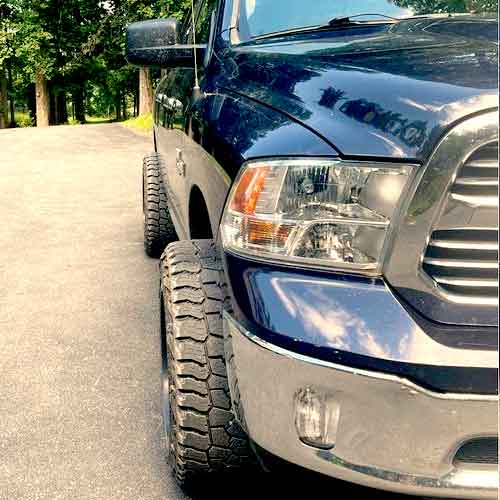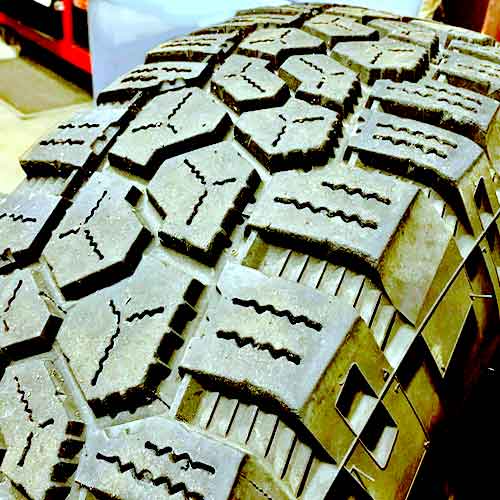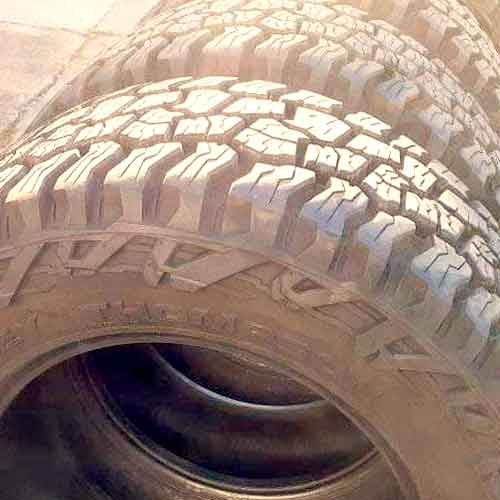Both the Mickey Thompson Baja Boss A/T and Cooper Rugged Trek are rugged-terrain tires, though they are marketed as all-terrain. These tires essentially bridge the gap between A/T and M/T, as they have mixed tread features from both sides.

From my vantage point as a tire engineer, both tires supply very similar performance on wet roads, and dry roads but the Cooper Rugged Trek offers superior steering and handling capabilities there still, whereas it isn’t able to keep up as much in the acceleration and braking department. Mickey Thompson Baja Boss A/T on the other side, is silent off the two, performs on snow like a champ, and shines off road when it comes to climbing rocks. Though Cooper does better with muddy terrains.
Cooper Rugged Trek offers 18 total sizes (16 to 20″ rims), with following specs.
- Speed rating: T or Q.
- Load rating: XL, E and F, where 265/70R16 and 275/60R20 (only two sizes) also have SL range.
- Weight range: 40 lbs to 70 lbs.
- Tread depth: Either 16/32″ or 18.5/32″.
- LT sizes have 55k miles warranty, while others have 65k.
Conversely, the Mickey Baja Boss A/T provides 59 sizes (15″ to 24″) with following specs.
- Speed ratings: Q and T.
- Load ratings: SL, XL, D, E and F (no C).
- Weight range of 36 lbs to 90 lbs.
- Tread Depth: Either 16/32″ or 18.5/32″.
- 60k miles warranty for non LT sizes, while 50k miles for LT sizes.
Both have similar speed ratings, tread depth, and warranties. Moreover, both also offer 3 peak mountain snowflake ratings along with M+S.
Check out detailed review of Mickey Baja Boss A/T.
A Side Note: I worked with these guys to make the following video:
Table of Contents
Design Features
Both tires, although look slightly different on a closer inspection, they both have similar kind of structure on the paper, though that’s not surprising as Mickey Thompson was owned by Cooper Tires (and they both now come under Goodyear).

Let’s start things off with Cooper Rugged Trek tire, from the sides.
The tire offers sidewall lugs of elongated design having biters/notches embedded in them, which help off road in grabbing and pulling (with lowered air pressure).
The shoulder lugs are staggered adding to aggressiveness, and are equipped with full depth interlocking sipes (making a wave-like pattern).
The blocks although make wider gaps here in between, they are joined together with ridges and the base of the tread there have multiple stone ejectors (a lining structure is seen).
These grooves are the widest compared to the rest.
In the middle all lugs carry a same design of “Y” shaped interlocking siping and sharp off set edges, enhancing chewing power of the tire.
These lugs also make grooves interconnecting with each other and making this tire very efficient in self cleaning (that’s why its so good with mud, but more on that later).
Let’s look at the Mickey Thompson Baja A/T.

Now, this tire although makes more aggressive sidewall lugs which supplies better lateral traction, especially on rocks, the tire does not have staggered shoulder lugs, though each block has sharp traction notches on outer edges.
These lugs create wider lateral grooves in between compared to longitudinal channels in front of them (just like the Cooper Rugged Trek).
The grooves are equipped with multiple stone ejectors too, but here they are triangular shaped.
In the middle you see two ribs of almost similar design, where on one rib, the only thing different is lateral and longitudinal notches (cuts dividing the blocks, though they are not separated all the way).
Other than this, they carry same kind of notches, sharp edges and siping pattern (which is also similar to the ones on shoulder lugs).
Durability
Off-Road tires need to be powerful as they encounter a lot of stuff that can pierce through them, and here the most vulnerable area is the tire’s sidewalls.
But that’s not a problem for Mickey Thompson A/T, as the tire offers 3 ply polyester casing, under those thick lugs of its sidewalls. I mean it’s a challenge to pierce it’s bead area.
Moreover, the tire also features 2 cap plies of nylon and steel belts on top of that cover as well.
On the other side, the Cooper Rugged Trek has a weaker built, as it only offers an average 2 ply polyester casing, with belts and just a single cap ply of nylon.
So where it’s sidewalls are weaker, it’s central area of the tread is also not as strong, in comparison, as well.
Though, one thing to keep in mind, that with higher durability, the Mickey Thompson A/T also increases it’s weight drastically, which is inversely proportional to steering response times.
Winter Capability
All-terrain tires are getting better with winter performance, and that’s because they are now incorporating a few crucial tread features of winter tires.
Like, they are made soft to endure freezing winter temperatures. And their notches and sipes are designed in a way, to grab snow particles and make better snow to snow exposure.
Mickey Thompson Baja Boss A/T is a great tire for snow. It’s not only better in comparison here, but in fact, it’s one of the top performing ones, that’s why I added this tire for this, in my list of best all time all-terrain tires. Check it out here: https://tiredriver.com/best-all-terrain-tires/
Cooper Rugged Trek on the other hand, although does okay with deeper snow, its wider grooves are not able to keep the snow in, and it’s stiffer rubber gets frozen up more quickly, which limits its traction capabilities.
Dry Traction
Dry traction has a lot to do with how a tire is in terms of acceleration and braking (how fast a tire can stop with full braking), lateral stability and it’s sensitivity to steering. Let’s talk all of these.
Grip of the tire is calculated by braking and acceleration times. In order to make tires better in these areas, their treads are optimized to have as much contact with surface as possible. And they make that contact mostly from the middle, when the tire moves directionally.
Mickey Thompson Baja Boss A/T does better here with it’s closed up lugs in comparison.
Cooper Rugged Trek on the other side, limits its grip as it’s rubber is eaten away with a lot of grooves and tread voids. And this goes especially for the shoulders, where if you consider the tread of both on top, you’d find that Cooper RT has a lot of gaps there.
Wet Performance
On wet roads, you need faster water removal. This brings two dimensions, grip and hydroplaning.
Let me start off with grip.
Wet Grip
Wet grip of the tire depends on siping, which basically suck in the water particles.
So these sipes need to have the flexibility to move as well.
Cooper Rugged Trek offers a slightly harder rubber compound on it’s tread.
Mickey Thompson Baja Boss A/T is also better because of hydroplaning.
Aquaplaning
Aquaplaning or Hydroplaning is simply the floating of a tire on water. So grooves play a crucial role here as they remove the excess water out and tire can move over standing water with more speeds.
Cooper Rugged Trek has ridges in between the shoulder gaps, so water is restricted to be removed sideways. And with less water evacuation, more water is left behind for sipes to clean off, so overall wet traction is further compromised.
Fuel and Tread Usage
Fuel efficiency and tread life are both linked to a tire’s rolling resistance. And that depends on a lot of other factors like the tread design, composition, tread depth and so on.
The Cooper Rugged Trek weighs similarly, but its rubber composition is stiffer, so although both tires have same rolling resistance values, Mickey Baja Boss AT still wears slightly faster, (where they both give off same miles per gallon).
So it makes sense, why Baja Boss A/T gives off 5k less tread wear warranty.
Ride Quality
While noise is only a part of the equation, combined with comfort, it determines the overall ride quality.
Noise primarily results from air hitting the tread and moving in and out of it due to pressure. Most of this noise comes from the tire shoulders, hence the use of ‘whisper groove technology’, a term coined by Cooper tires.
The Cooper Rugged Trek uses that technology and places ridges in between the shoulder lugs, so air movement in and out could be resisted.
However, the wider shoulder lugs of the Rugged Trek allow more air space, and it hits on the placed ridges with full forces, making this tire louder in comparison.
Mickey Thompson Baja Boss A/T on the other side, is although not so great, is better in comparison. It also offers whisper grooves with ridges in every other block, and it’s severe asymmetric design don’t allow air to hit the walls directly.
Moreover, with a softer built, it also deals with vibrations in a better way, where the bumps on and off road are dampened by it’s tread.
Off Road Traction Performance
In off-road conditions, there are various terrains to consider, and I’ve discussed the significant ones below.
On Sand
Sand is a weird terrain that requires paddle tires. But have you ever wondered why these tires perform so well here?
Well because of their contact patch.
They have a lot of tread real estate to meet with the sand. And they have powerful bead locks so you can lower air pressure further (to increase that contact patch).
Moreover, they are also light in weight so incline traction isn’t an issue as well.
With wider gaps in shoulder lugs, and having smoother edges, Cooper Rugged Trek offers better sand traction, as it focuses on moving forward instead of digging in.
Now digging in the sand is very undesirable, as it’s another name for “getting stuck” here. Thus, the Mickey Baja Boss A/T, with its sharp sides, struggles slightly, especially on deeper terrains and inclines.
On Gravel
Gravel terrain is the lightest of all, where even less aggressive A/T tires can bring you good enough results. That’s because tires don’t need large tread voids here, though larger voids are still better.
So it’s not a problem for tires in R/T category. However, among them, the Cooper Rugged Trek is less efficient due to its fewer stone ejectors compared to its counterpart.
Mickey Thompson AT on the other side must hold some kind of record for the “highest no. of stone ejectors seen on the tread”.
So it’s no surprise why things are better on this tire.
On Mud
The thick composition of the mud needs to leave off the tire as fast as possible, otherwise, it would get lodged in and invite other mud particles, packing up the tire and loosing it’s traction abilities.
Cooper Rugged Trek allows more mud to be ejected. It’s pattern between the shoulder lugs help breaking down the mud and it reminds me of tractive groove technology of Goodyear Duratrac.
While the Mickey Thompson Baja Boss A/T has multiple stone ejectors, it doesn’t offer as much traction on mud.
Moreover, the sides of the tire are not properly scalloped, so with better mud scoops on Cooper Rugged Trek, you get superior forward momentum.
On Rocks
Durability is crucial on rocky terrains, as tires frequently encounter scratches, especially on their sidewalls. While sidewall lugs protect the sides, the tire’s internal composition determines how much pressure it can withstand before puncturing.
Mickey Thompson Baja Boss A/T offers a better tire here as it’s sidewall lugs get to produce more biting power with lower air pressure.
The tire also presents a lot more biters in the form of chamfered edges, off-set sides, longitudinal and lateral in grown groove notches and so on.
Cooper Rugged Trek in comparison, lacks in the durability department as it only offers 2 ply sidewalls, though it’s lugs on top are good enough to provide ample traction with lowered PSI (compared to most A/T tires).
Take Home Points
Mickey Thompson Baja Boss A/T and Cooper Rugged Trek are both pretty aggressive all terrain tires and they cause a lot of confusion, as some consider them hybrid, some say they lie in rugged terrain category, all of these terms are actually correct.
These tires basically offer better off road traction compared to all-terrain tires, and at the same time, provide superior comfort if you compare them with mud-terrain tires.
Thus, they fit right in the middle of the spectrum between all-terrain and mud-terrain tires.
However, the Mickey Thompson A/T stands out due to its balanced performance both on and off-road, offering minimal compromise.
What an incredible article which happens to feature the two tires I always wanted to compare. I currently run the Cooper RT’s and can’t say I’m disappointed with them but I’m that guy always looking for other options if it happens to arise. This article definitely has me leaning towards the Baja’s in the fall of ‘24. Appreciate your knowledge
Thanks, I’m glad it helped.
Great article & writing. I was torn between the two tires but now I’m leaning toward the Mickey Thompson Baja AT because of better rain & snow grip & stronger side walls. Well written !
Perfect choice.